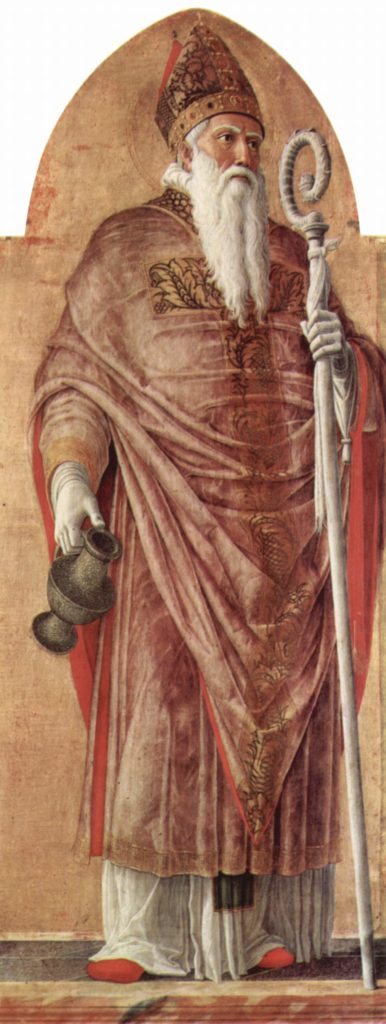– For the context of these translations click here –
 From the 4th century the bishops also exercised public law functions, and in late antiquity they became ‘lords of the civitas’ (cities), and the foundations of monasteries, increasingly frequent in their cities, further increased their power.
From the 4th century the bishops also exercised public law functions, and in late antiquity they became ‘lords of the civitas’ (cities), and the foundations of monasteries, increasingly frequent in their cities, further increased their power.
The high clergy steadily seized all possible powers. It took advantage, for example, of the release from military service, which it so inflexibly imposed on others. The same was true of the release from taxes and duties, which it naturally imposed on others. At least until the 5th century, the bishops were exempted from the annual grain tax (annona) and from the land tax on all church property, as well as from the munera sordida (dirty work) and the extraordinaria (special allowances). They fought for emancipation from other public obligations and for new rights, such as the right of asylum for their churches, which was so abused.
They also acquired ecclesiastical jurisdiction, the privilegium fori. And they increasingly extended their juridical authority. They had almost unlimited jurisdiction over their clergy, and in certain cases even over the laity, while they could only be condemned by an episcopal assembly. And secular judges, who without their authorisation pronounced on canon law, were excommunicated.
The clergy needed the bishop’s permission to do anything. The bishop also held sway in the monasteries. It was the bishop who decided on the legates to the monasteries, subjected the abbots in matters of appointment and penalties, and had almost unlimited authority over the monks.
But the influence of the bishops was all the greater because the Germanic kingdoms of the 5th and 6th centuries did not touch the possessions of the Church at all. Moreover, the Church’s possessions were increased by the extensive donations of the kings in the 6th and 7th centuries, as well as by many other transfers of property. In a short period, the Church became ‘the largest landowner after the king’ (Stern/Bartmuss).
The throne and the altar
It is true that the growing power and wealth of the Church led to certain tensions and disagreements. But monarchy and episcopate saw that they depended on each other and worked together. The hierarchical structure of the Frankish national church supported the political system, and the political system in turn favoured it. It was the old Do ut des business. A ‘tight intertwining of state and church’ (Aubin) prevailed. It was precisely the most powerful families of the Merovingian kingdom—the lineages of the Waldeberts, the Burgundopharones, the Crodoins, the Arnulfingians and the Pipinids—who reinforced their old privileges through Christianity and even through the work of the saints who came from their ranks, the ‘domestic saints’.
Of course, these princes also recognised the ecclesiastical authority of the pope, who in turn could hardly impose his decisions against the royal will. The Merovingians often had ecclesiastics in their court administration and bestowed episcopal sees as sinecures on meritorious fighters. They showered some prelates with enormous possessions and privileges, but almost all were treated with great veneration.
The most powerful bishops had particularly extensive holdings, occupying an almost feudal position. Some even maintained personal relations with the emperor of Byzantium. They were protected and dominated by Merovingian kings, who became the princes’ godfathers. They not only accepted their violence but supported it, complacently sanctioning their wars and cruelties.
In addition to the ever-increasing Church lands—which represented an enormous and, to say it again, inalienable source of income—there were other financial advantages. Such were, for example, the offerings, the raising of taxes, the tithe, which was invented in the 5th century as a kind of alms until the end of the 6th century when it was transformed from a moral obligation into a legal duty, with corresponding penalties for transgressors. Anyone who refused to pay it was excommunicated. A document, drawn up shortly after the Council of Tours (567) and signed by the metropolitan of the place and three of its bishops, demanded that the faithful pay the tithe, and not only of goods but also of slaves. This is the first time that the tithe is mentioned in a Merovingian text. The Synod of Macon threatened excommunication against anyone who violated the correct application of the tithe. In 779, under Charles ‘the Great’, it became a compulsory tax.
The bishops, who had long since ceased to come from the middle class of society—Chlothar II (584-629) made it a rule that they should be chosen from among the members of the upper nobility—oppressed the people with the rest of the ruling class. Sometimes they ruled like true despots. They hardly fornicated and drank less than the laity. Sitting at the king’s table, they spoke of their perjuries and adulteries; Bishop Bertram of Bordeaux was even suspected of having had something to do with Queen Fredegund. They often appointed their successors themselves.
It happened that some towns even had two bishops at the same time. Thus, in Digne-les-Bains, two bishops divided the ecclesiastical property between them, before a synod deposed them both. Something similar happened in the monasteries, which also represented from the 5th century onwards important points of support in the urban sphere for the episcopal government of the cities, since from the 6th century onwards they multiplied considerably and from the 7th century onwards they belonged to the most important landowners in the country, often becoming richer than the cathedrals of the bishops themselves. At the end of the 7th century, when there were more than four hundred monasteries in the whole kingdom, such monasteries and churches owned a third of Gaul!